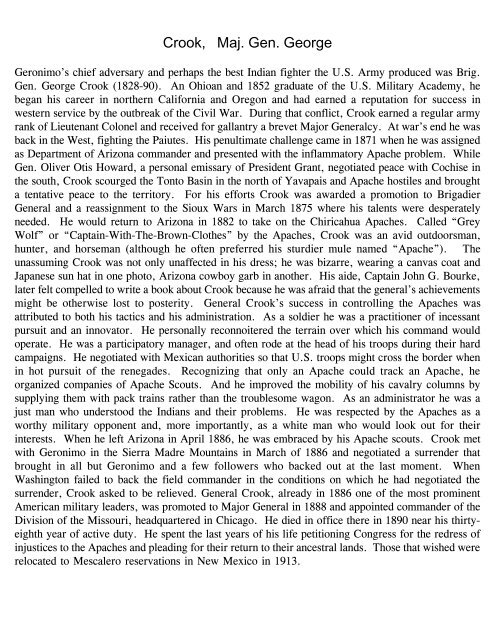Create successful ePaper yourself
Turn your PDF publications into a flip-book with our unique Google optimized e-Paper software.
Crook, Maj. Gen. George<br />
Geronimo’s chief adversary and perhaps the best Indian fighter the U.S. <strong>Army</strong> produced was Brig.<br />
Gen. George Crook (1828-90). An Ohioan and 1852 graduate of the U.S. Military Academy, he<br />
began his career in northern California and Oregon and had earned a reputation for success in<br />
western service by the outbreak of the Civil War. During that conflict, Crook earned a regular army<br />
rank of Lieutenant Colonel and received for gallantry a brevet Major Generalcy. At war’s end he was<br />
back in the West, fighting the Paiutes. His penultimate challenge came in 1871 when he was assigned<br />
as Department of Arizona commander and presented with the inflammatory Apache problem. While<br />
Gen. Oliver Otis Howard, a personal emissary of President Grant, negotiated peace with Cochise in<br />
the south, Crook scourged the Tonto Basin in the north of Yavapais and Apache hostiles and brought<br />
a tentative peace to the territory. For his efforts Crook was awarded a promotion to Brigadier<br />
General and a reassignment to the Sioux Wars in March 1875 where his talents were desperately<br />
needed. He would return to Arizona in 1882 to take on the Chiricahua Apaches. Called “Grey<br />
Wolf” or “Captain-With-The-Brown-Clothes” by the Apaches, Crook was an avid outdoorsman,<br />
hunter, and horseman (although he often preferred his sturdier mule named “Apache”). The<br />
unassuming Crook was not only unaffected in his dress; he was bizarre, wearing a canvas coat and<br />
Japanese sun hat in one photo, Arizona cowboy garb in another. His aide, Captain John G. Bourke,<br />
later felt compelled to write a book about Crook because he was afraid that the general’s achievements<br />
might be otherwise lost to posterity. General Crook’s success in controlling the Apaches was<br />
attributed to both his tactics and his administration. As a soldier he was a practitioner of incessant<br />
pursuit and an innovator. He personally reconnoitered the terrain over which his command would<br />
operate. He was a participatory manager, and often rode at the head of his troops during their hard<br />
campaigns. He negotiated with Mexican authorities so that U.S. troops might cross the border when<br />
in hot pursuit of the renegades. Recognizing that only an Apache could track an Apache, he<br />
organized companies of Apache Scouts. And he improved the mobility of his cavalry columns by<br />
supplying them with pack trains rather than the troublesome wagon. As an administrator he was a<br />
just man who understood the Indians and their problems. He was respected by the Apaches as a<br />
worthy military opponent and, more importantly, as a white man who would look out for their<br />
interests. When he left Arizona in April 1886, he was embraced by his Apache scouts. Crook met<br />
with Geronimo in the Sierra Madre Mountains in March of 1886 and negotiated a surrender that<br />
brought in all but Geronimo and a few followers who backed out at the last moment. When<br />
Washington failed to back the field commander in the conditions on which he had negotiated the<br />
surrender, Crook asked to be relieved. General Crook, already in 1886 one of the most prominent<br />
American military leaders, was promoted to Major General in 1888 and appointed commander of the<br />
Division of the Missouri, headquartered in Chicago. He died in office there in 1890 near his thirtyeighth<br />
year of active duty. He spent the last years of his life petitioning Congress for the redress of<br />
injustices to the Apaches and pleading for their return to their ancestral lands. Those that wished were<br />
relocated to Mescalero reservations in New Mexico in 1913.

















